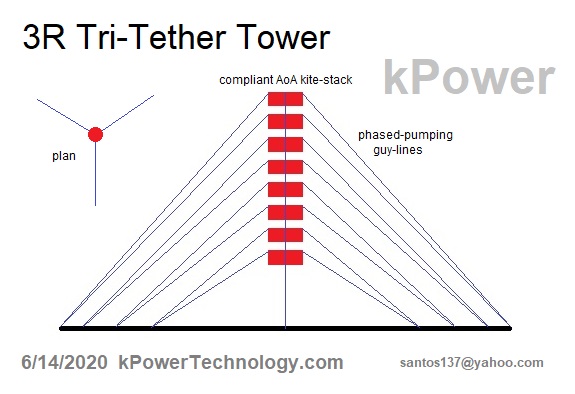3r Tower Concept
Some background
We could not interest early Cablecam in 1:1 small-scale AWE R&D, with their winches.
KiteLab Ilwaco had pioneered 3r AWES in 2009, so it was gratifying that TUK provided independent third-party concept validation, if a decade later. We also did first 3r persistent-flight demos at AKA Windless Kite Festival. Forgive us for racing to beat Google for world-first self-flying groundgen (kitemotor1 2007). Our classic kite autonomy basis was identified as a Quantum Computing analogue. Joe and I were invited to write a bit in Physics World, and our kite-QM analogy passed review there, and with various other physicists. kPower came to see in 3r a "kitematter" metamaterial unit-cell lattice basis at aggregated GW scale, and TUK and ASU are on that.
For Mars operations: 1r v. 3r AWES on Mars
TU Delft students should be encouraged to consider various AWES topologies for Mars design, not just the 2007 reeling patent 1r topology.
3r AWES on Mars deployed from three suitable hills would be a far more robust and effective design, resolving already formidable 1r limitations at sea-level air density. 1r at 30km-altitude Mars-equivalent pressure density is a glaring AWES topology down-select error. Even 3r is quite marginal for Martian conditions, for all its tremendous advantages.
3r is favored on Earth at sea-level, as well. TUD curriculum has completely overlooked 3r topology for twelve years (KiteLab Ilwaco), and many other long-known AWES detail-engineering solutions. TU Delft students are left poorly prepared to contribute superior alternative AWES solutions. TU Kaiserslautern students learn 1r and 3r, to better "think outside the box".
Let TUD students compare 3r to 1r for Mars-
https://iopscience.iop.org/article/10.1088/1742-6596/1037/4/042023/pdf
Wubbo Lives!
=======================
And:
Consider well whether Kitepower should pivot to 3r AWES R&D by simply repurposing its motor-gen winch units to serve in sets of three. 1r topology cannot inherently resolve launching, reverse-pumping, and breakaway-risk gaps. 3r can. All 1r ventures face this wall.
Kitepower's current course continues deeply problematic, willfully covering up the tether disposition nightmare of the Valkenburg crash, which could not have happened if you had already adopted 3r topology. The cover-up is mostly about anecdotal confirmation of long well understood breakaway hazard, and "the cover-up is worse than the crime".
Future AWES crashes will drive increasing transparency, especially as injuries and fatalities occur. These may be laid back on Kitepower, to the extent they failed to report revealed hazards comprehensively, in actionable form. Makani is also on the hook for its Norway crash data and full report.
Read TUK's 3r paper linked below. Study prior US art and emerging scaling breakthroughs overlooked by AWEurope's venture insider circle. Roland faces the same techno-ontological crisis in advising TUD students to stick to 1r, or study 3r comparatively for a more optimal Mars AWES design.
Please reach out for collaboration with TUK and kPower, if you see 3r to be a promising AWES topology option, for Kitepower never to have another mishap like Valkenburg, with possibly tragic results. Consider advising other TUD spin-off ventures to embrace 1r-3r comparative testing, and maybe bring everyone together.
https://iopscience.iop.org/article/10.1088/1742-6596/1037/4/042023/pdf
3r Tower Concept
Could scale well to ~1 km high and ~100 MW rated output; many theoretic advantages:
